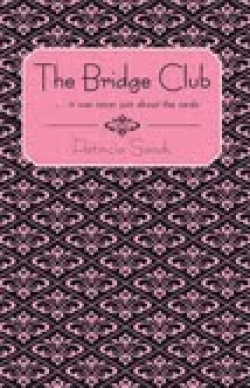The Bridge Club
- 2010 INDIES Finalist
- Finalist, General (Adult Fiction)
For those who greet the arrival of a favorite women’s magazine as a special occasion that calls for a nice cup of tea and a quiet, solitary hour, Patricia Sands’ The Bridge Club will justify both a full pot of tea and a long, undisturbed afternoon in a comfy chair.
The slow, rather passive opening of the novel is initially off-putting, but its purpose eventually becomes clear. Clichés, song lyrics, and inspirational quotes abound as Sands introduces her eight female characters and offers a short explanation of their 40-year history as friends and members of an exclusive club. It quickly becomes apparent that neither the club nor the book itself is truly about bridge: “It was a given that they could each identify experiences, some lasting longer than others, when family or other support was not the answer and the BC had come to the rescue…The Bridge Club has been a life raft, keeping us afloat when we needed it.”
Each of the next eight chapters, one for each club member, effectively presents a life-shattering event that is survived, thanks to the love and support of the group. These women’s magazine-type stories will bring some readers to tears and perhaps allow them to better understand and handle their own problems or those of their loved ones. Sands addresses numerous issues: alcoholism, divorce, death of a spouse, adoption, breast cancer, and lesbianism, among others. While none of the issues are explored in great depth, each illustrates the difference in outcome that a solid support network can make.
Certainly, the characters in The Bridge Club are lovely women, and some of them seem almost familiar. Their individual personalities are distinct and well presented. They tease and cajole. They are always willing to jump in with an opinion. And they are grateful to one another: “I sure needed you guys. Thanks for steering me through this mess. Not just in figuring out what might be going on but for keeping me on an even keel.”
Sweetness and appreciation prevail. Sands stresses laughter and respect as keys to the friendship—the “support of sisters”—that her characters share. Yoga and golf also figure prominently, and religion occasionally makes an appearance. Realistically, however, how likely is any contemporary woman to be part of a tight-knit group of eight friends who can and will drop everything when she is in crisis? How likely are any eight women to stay in one place for forty years? Sands, herself, apparently shares such a bond with her own bridge club, but for most women today, it is not a plausible scenario.
Perhaps it is this very implausibility that will make The Bridge Club appealing to a great number of readers, undoubtedly mostly female. After all, who wouldn’t love to have a dedicated group to whom she might take “every opportunity to vent, cry, swear and question”? Who doesn’t occasionally crave a bit of support when confronting a moral dilemma? Oprah fans will likely enjoy the book’s uplifting qualities. Others may find Sands’ story a bit too saccharine and her solutions to life’s challenges a bit too pat.
Reviewed by
Cheryl M. Hibbard
Disclosure: This article is not an endorsement, but a review. The publisher of this book provided free copies of the book and paid a small fee to have their book reviewed by a professional reviewer. Foreword Reviews and Clarion Reviews make no guarantee that the publisher will receive a positive review. Foreword Magazine, Inc. is disclosing this in accordance with the Federal Trade Commission’s 16 CFR, Part 255.

